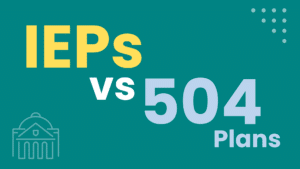IEPs vs. 504 Plans
Welcome to our educational exploration! In a previous post, we discussed some of the ins and outs relating to SLDs, IEPs, and IDEA, and many of you wondered about the often-overlooked hero: Section 504 and its trusty sidekick, “504 plans.” This piece breaks down the similarities and differences between a 504 plan and an IEP.
Let’s connect each of these documents to the federal law
- Individualized Education Program (IEP) → Individuals with Disabilities Education Act (IDEA). Most legal protections are clearly defined in the law’s statute (the actual written law).
- 504 Plan → Section 504 of the Rehabilitation Act. The Rehabilitation Act’s regulations (standards adopted by administrative agencies that govern enforcement) dictate 504 plans. In fact, the U.S. Department of Education is currently working to update Section 504’s regulations. When those are developed and finalized as a “final rule,” there may be changes to how the law is implemented.
It’s also important to remember that Section 504 applies to more than just K-12 schools. It’s an important civil rights law that protects people with disabilities from discrimination in programs or activities that receive federal funding, like public schools, but also most colleges and universities, and many other programs and settings.
Key Similarities
- Free Appropriate Public Education
504 plans and IEPs require the school district to provide students with a free appropriate public education (FAPE). An IEP and a 504 plan contain individualized information about the accommodations and related services the student receives to ensure they receive FAPE.
- Evaluation
An evaluation process requires procedures to ensure students are not misidentified. School districts may use the same process to evaluate students under Section 504 and IDEA. Suppose districts choose to adopt a separate process for evaluating the needs of students under Section 504, which might result in the student receiving a 504 plan. In that case, they must follow the requirements for evaluation specified in the regulations of Section 504.
- Legal Documents
Both IEPs and 504 plans are legally binding documents that must be followed. Both IDEA and Section 504’s regulations for Preschool, Elementary, and Secondary education have “procedural safeguards,” which are specific rights and procedures that enable families to participate and ensure their child is receiving FAPE, such as the right for the parent/guardian to examine relevant records and due process rights for resolving disputes. Compliance with the procedural safeguards of IDEA is “one means of meeting the procedural safeguards” requirement in Section 504.
Notable Differences
- Eligibility
To have an IEP, a student must be found eligible by having one of the 13 disability categories in IDEA and require special education or related services to make progress in school. A student can be considered disabled and may receive the protections of Section 504 and classroom accommodations, even if they do not qualify for special education under IDEA (in these instances, the student usually receives a 504 plan). Section 504 has a broader definition of disability than IDEA, and is why a student who does not qualify for an IEP may receive a 504 plan.
- Funding
Recognizing that the provision of special education and related services as outlined in the IEP can be costly, the federal government provides funding for state grants for IDEA. The average per pupil expenditure is estimated at approximately $17,000 (source: USED), and the federal government contributes about 12% of that.
Unlike IDEA, Section 504 provides no financial support to school systems. Students with an IEP are counted in the overall IDEA child count at the federal level, which is used for funding formulas, but students with 504 plans are not included in that count.
- Content and Intent
While both IEPs and 504 plans are individualized for the student’s specific needs, they differ in what they provide for the student in school. A 504 plan is focused on ensuring that the student receives the necessary accommodations to access the general education curriculum and remove barriers, such as testing accommodations or a classroom accommodation like preferential seating. An IEP will likely include accommodations but may also include modifications that modify the general education curriculum. A student with an IEP may also have specific interventions (i.e., a reading intervention) or services provided (i.e., speech-language pathology).
In general, IEPs are more robust than 504 plans. They are updated more regularly with specific and measurable annual goals and require the expertise of a certified special education teacher or “IEP case manager” to lead the IEP team in developing IEP goals and reviewing progress. Schools or districts might have a “504 coordinator” who develops and oversees 504 plans, but it also could be a school counselor, another teacher, or even an administrator developing and overseeing.

